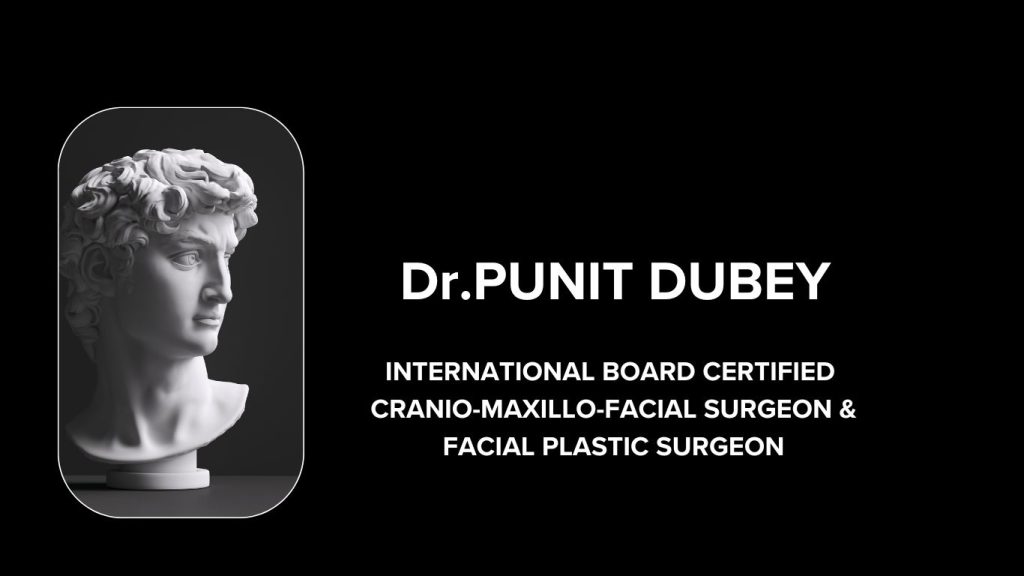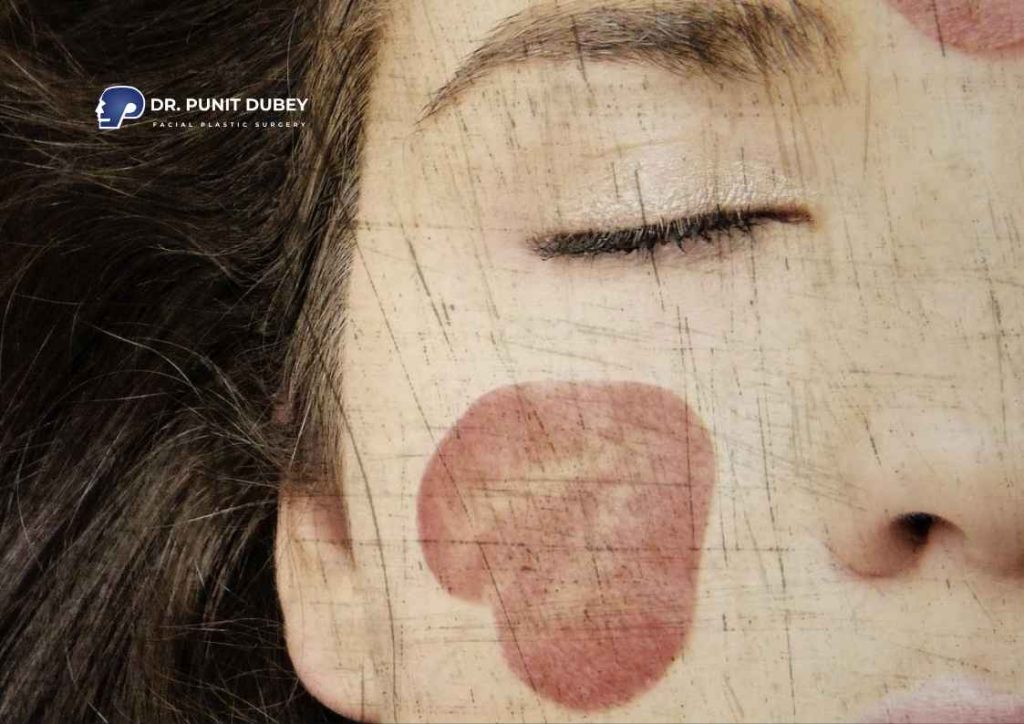
Facial Birthmark Removal in Delhi, India
A facial birthmarks can be a unique and defining feature — a splash of color, a patch, or a mark you’ve had since birth. But for many, especially when it’s a large facial pigmentation or one with visible hair, it can affect self-esteem, comfort in social settings, or even have psychological effects. Whether you’re seeking treatment for cosmetic reasons or underlying health concerns, advanced facial birthmark removal in Delhi offers safe, effective, and permanent options tailored to your skin type and goals.
This detailed guide covers everything from the causes and types of birthmarks to the latest removal procedures, real patient results, and why Delhi, with experts like Dr. Punit Dubey, is one of the leading choices for facial birthmark treatment in India.
Table of Contents
Birth mark on Face Types
Facial birthmarks are marks or raised areas on the skin that form around birth and can differ widely in their appearance, size, texture, and underlying cause. The root causes typically fall into three broad categories:
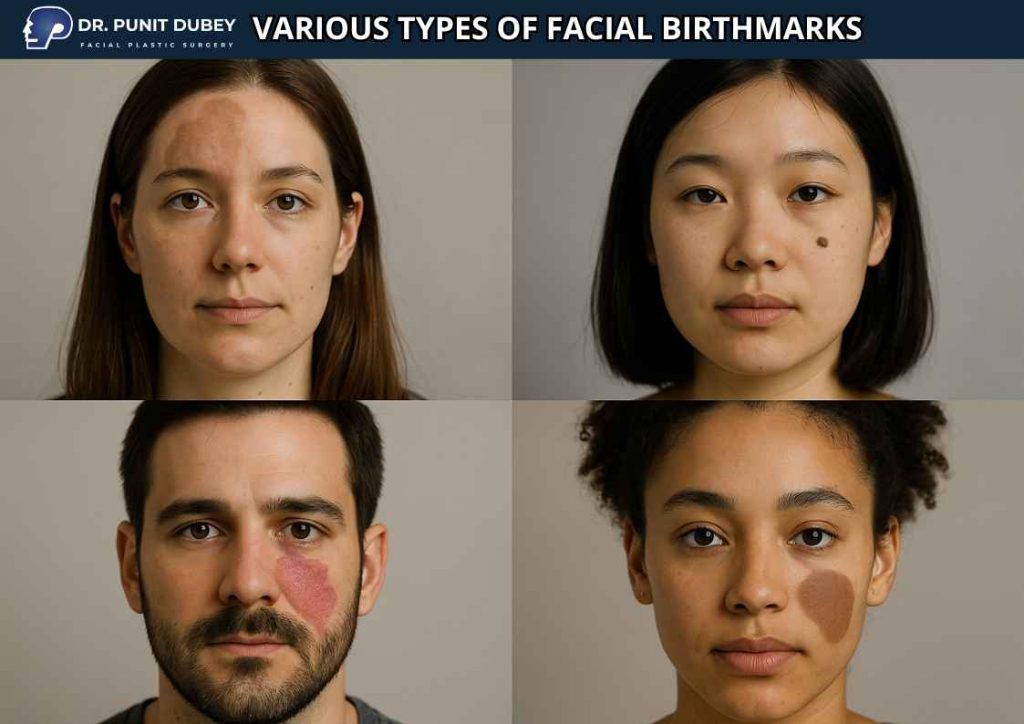
- Vascular Birthmarks (Blood Vessel-Related)
These occur when blood vessels under the skin form abnormally during fetal development. Common examples include:
- Port Wine Stain: Flat, reddish to purplish discoloration that tends to darken and thicken with age. It often persists without fading.
- Hemangioma of Infancy: Raised red or blue growths that may appear in the first weeks after birth and grow rapidly before gradually shrinking.
- Nevus Simplex (Salmon Patch): Pale pink or red patches commonly seen on the forehead, eyelids, or neck. These often fade over time.
- Pigmented Birthmarks (Melanin-Related)
These develop due to irregularities in melanin — the pigment responsible for skin color. They include:
- Congenital Melanocytic Nevi: Present at birth and may be brown, black, or hairy. Larger nevi can pose an increased risk of skin complications.
- Café au lait spots are light tan to brown areas on the skin that may occur alone or in clusters.
- Nonmelanocytic or Epidermal Birthmarks
These arise from overgrowth of skin cells rather than pigment or blood vessels. Examples include:
- Nevus Sebaceous: Yellowish or orange patches that may appear on the face or scalp, often becoming more raised during adolescence.
- Epidermal Nevi: Thick, wart-like skin streaks or patches, caused by excess epidermal cell growth.
While most birthmarks are benign, some can grow, become raised, develop hair, or trigger aesthetic or psychological distress. In rare cases, certain types may require medical intervention due to their size, location, or potential for complications.
Birthmarks in Infants
It’s common for newborns to have some kind of facial birthmark, and for parents, it often brings up a mix of emotions — curiosity, concern, and questions about what’s normal and what might need treatment.
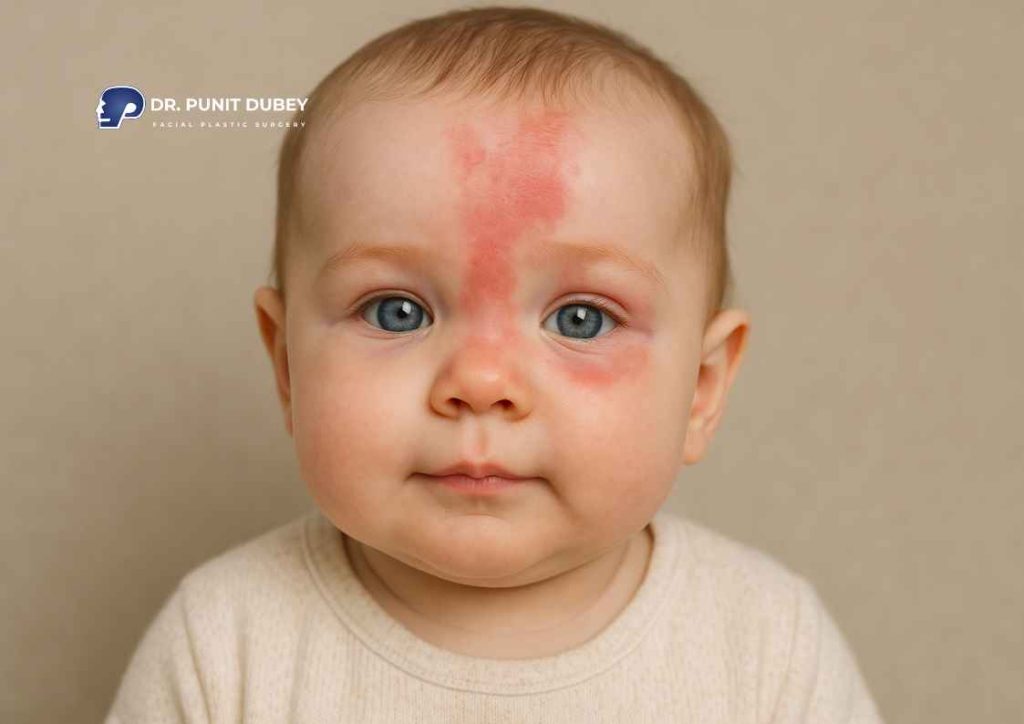
Are Infant Facial Birthmarks Common?
In fact, most birth marks are benign and tend to fade or vanish naturally over the years. Others, particularly those that are large, raised, or located near sensitive areas like the eyes or mouth, may require early evaluation.
Here are some common facial birthmarks seen in infants:
- Salmon Patch (Nevus Simplex): Appears as a flat, pink patch, often on the forehead or eyelids. These are the most common vascular birthmarks in newborns and typically fade by age two.
- Infantile Hemangioma: These red, raised marks can appear a few weeks after birth and may grow rapidly during the first year. While many shrink on their own, facial hemangiomas near the eyes, nose, or mouth may interfere with function or leave permanent scarring without treatment.
- Congenital Melanocytic Nevus: Present at birth, these pigmented lesions may range from light brown to black and can be flat or slightly raised. They may grow in proportion to the child and sometimes develop visible hair.
- Port Wine Stain: Unlike some other birthmarks, this one doesn’t fade. It often darkens and thickens with age. Early laser treatment is typically recommended to minimize long-term cosmetic or tissue changes.
Should All Infant Birthmarks Be Treated?
Not necessarily. Many birthmarks, especially vascular ones like hemangiomas or salmon patches, resolve on their own and don’t require intervention. However, treatment may be advised in the following cases:
- If the birth mark is growing rapidly
- If it affects critical areas like the eyes, lips, or airway
- If there is a risk of permanent skin damage or ulceration
- If it leads to psychological distress as the child grows older
Pediatric evaluation, preferably with a facial plastic surgeon experienced in infant care, is essential to determine whether early treatment is necessary. In some cases, timing is critical — early laser therapy or medication can prevent complications and deliver better aesthetic outcomes.
Indications of Facial Birthmark Treatment
Not all facial birthmarks need removal, but there are specific scenarios where medical or aesthetic treatment becomes necessary. Whether it’s for infants, children, or adults, the decision to pursue treatment often depends on the congenital skin mark’s type, size, growth pattern, and impact on daily life.
When Should You Consider Facial Birthmark Removal?
Here are the most common indications for seeking treatment:
- Cosmetic or Aesthetic Concerns
A visible or large facial birthmark, especially on prominent areas like the forehead, cheeks, or nose, can affect one’s self-image and confidence. A large number of people pursue birthmark removal primarily for aesthetic reasons, especially when the mark:
- Becomes darker, thicker, or hairier with age
- Distorts facial symmetry
- Causes embarrassment or social discomfort
- Functional Impairment
Certain birth marks — particularly hemangiomas or port wine stains — when located near the eyes, lips, or airway, can affect function. Treatment may be indicated if the mark on face interferes with:
- Vision (eyelid hemangiomas or lesions near the eye)
- Breathing (nasal or airway involvement)
- Eating or speech (lips or perioral region)
- Progressive Changes or Complications
Some may worsen over time or develop complications, such as:
- Ulceration or bleeding
- Thickening and nodular changes in port wine stains
- Malignant transformation risk in large congenital nevi
- Infection risk in epidermal nevi
Early treatment can reduce these risks and lead to better long-term outcomes.
- Psychosocial Distress
Children and teenagers, in particular, may experience bullying, self-consciousness, or emotional stress due to their appearance. In these cases, even a benign birthmark may become a significant psychological burden — a strong indication for facial birthmark removal.
- Parental Choice in Infants
Parents may opt for early intervention if they anticipate future issues with school-age appearance, social integration, or if medical advice recommends early removal due to size, location, or growth.
The Process of Facial Birthmark Removal in Delhi
In Delhi, advancements in facial surgery, lasers, and reconstructive facial procedures have made facial birthmark removal more precise, safe, and tailored than ever before. Whether you’re dealing with a vascular, pigmented, or epidermal, understanding the treatment journey helps you feel informed and empowered.
Initial Consultation
The first step in your journey begins with a comprehensive consultation with an experienced facial plastic surgeon. During this visit, several factors are assessed:
- Is classified as vascular, pigment-based (melanocytic), or derived from skin cells (epidermal)
- Size, depth, and color
- Presence of hair or nodular changes
- Age of the patient (infant, adolescent, or adult)
- Location and proximity to vital facial structures
- Your goals and expectations
High-resolution photographs may be taken for comparison, and in some cases, imaging or dermoscopy might be used to evaluate depth. Based on this, a personalized treatment plan is recommended — whether it’s laser therapy, surgical excision, or a combination of modalities.
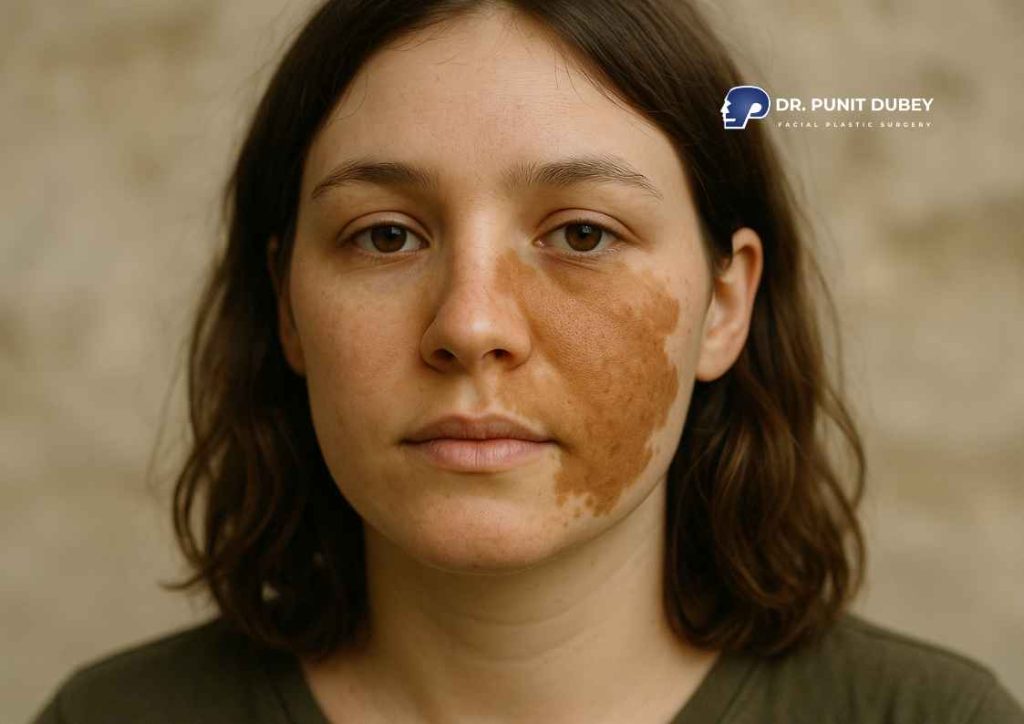
Facial Birthmark Removal Process
Laser Facial Birthmark Removal
For many vascular and pigmented birthmarks, laser therapy is the gold standard. In Delhi, cutting-edge technologies like Pulsed Dye Laser (PDL), Q-switched Nd:YAG, and fractional lasers are widely available and effective.
Laser therapy works by targeting pigment or blood vessels beneath the skin:
- Pulsed Dye Laser (PDL) works especially well for treating port wine stains and infantile hemangiomas
- Q-switched lasers work well for pigmented lesions like café au lait spots
- Treatment often involves several laser sessions, each scheduled a few weeks apart to allow for healing and optimal results
This method is non-invasive, virtually painless, and has minimal downtime — making it ideal for children and adults alike.
2. Facial Birthmark Surgery Procedure
Surgical excision is often recommended for:
- Large congenital melanocytic nevi
- Epidermal nevi
- Nevus sebaceous
- Birthmarks with hair or nodular growth
Under local or general anesthesia (depending on the size and age of the patient), the lesion is carefully removed, and the surrounding skin is closed using aesthetic suturing techniques to minimize scarring. In some cases, serial excision or skin grafting may be required for larger lesions.
Surgical removal ensures complete excision and is particularly effective for lesions at risk of recurrence, complications, or potential malignancy.
Facial Birthmark Removal Recovery Time
Recovery depends on the treatment type:
- Following laser procedures, patients might notice brief redness, mild puffiness, or slight bruising that fades within a few days. Most individuals resume daily routines within one to two days.
- Surgical removal: Healing typically takes 7 to 14 days.
- Your surgeon will provide personalized post-procedure instructions, including sun protection and wound care to optimize healing and cosmetic outcomes.
Benefits of Facial Birthmark Removal
Undergoing facial birthmark removal isn’t just about aesthetics. For many individuals, it’s a deeply personal decision that can bring significant improvements to both their physical appearance and emotional well-being.
- Enhanced Facial Appearance
A visible large facial birthmark, especially on the cheeks, forehead, or around the eyes, can draw unwanted attention. Removal helps:
- Improve facial symmetry
- Restore a more even skin tone
- Reduce raised or textured skin areas
- Eliminate unwanted hair in pigmented nevi
This leads to a noticeable aesthetic enhancement, especially in high-definition social environments or professional settings.
- Boost in Confidence and Self-Esteem
Many patients — including children, teenagers, and adults — report feeling significantly more confident after removing a prominent facial birthmark. If a visible skin mark influences how others perceive you or causes self-consciousness, having it removed can be an emotionally freeing experience.
This benefit is especially valuable for school-aged children who may face teasing or social anxiety due to visible marks.
- Preventing Future Complications
While many birthmarks are harmless, some (such as congenital melanocytic nevi or nevus sebaceous) carry a small risk of:
- Skin irritation or ulceration
- Infection
- Malignant transformation
Early intervention in such cases can reduce these risks and eliminate the need for more complex treatment later.
- Functional Improvement
In select cases, birthmarks near vital facial structures can affect:
- Vision (eyelid or orbital involvement)
- Breathing (nasal or airway compression)
- Feeding and speech (lip or oral)
Treatment can help restore normal function and developmental milestones in children.
- Psychological Relief for Parents
For parents of infants or toddlers with visible or large birthmarks, early removal provides peace of mind. It can prevent future concerns about school life, self-perception, or medical complications.
Facial Birthmark Removal Side Effects
While modern techniques have made facial birthmark removal safer and more effective than ever, like any medical procedure, it’s important to understand the potential side effects and risks — especially when the treatment involves sensitive facial skin.
Common Side Effects
Most patients experience minor, temporary reactions that subside within a few days. These may include:
- Temporary inflammation or puffiness may occur at the area treated
- Mild bruising, particularly after laser therapy
- The skin might feel slightly sensitive or tight as it begins to recover
- Scab formation or light peeling in laser-treated areas
These are typically self-limiting and can be managed with appropriate aftercare, including gentle cleansing and sun protection.
Possible Surgical Side Effects
For those undergoing surgical birthmark excision, side effects may include:
- You may experience low-level soreness or mild discomfort near the surgical area
- Some temporary scarring may develop, influenced by how deep or large the pigmented patch was
- There’s a small chance of infection, which can usually be avoided with correct post-care hygiene
- Skin around the treated spot may lighten or darken slightly as it heals
However, when performed by an experienced facial surgeon using meticulous techniques, scarring is often minimal and can be further reduced with follow-up treatments like scar creams or laser resurfacing.
Long-Term or Rare Risks
Infrequent but possible complications may include:
- Incomplete removal, particularly in deeper vascular birthmarks requiring multiple sessions
- Recurrence of the lesion if underlying cells remain
- Skin texture changes in large treated areas
- In rare instances, an allergic response to numbing creams or medications might occur
In cities like Delhi, patients have access to top-tier specialists who follow stringent safety protocols and tailor treatments based on birthmark type, location, and patient profile.
What makes Facial Birthmark Removal in Delhi with Dr. Punit Dubey the preferred choice for patients seeking expert care?
When it comes to treating something as visible and personal as a facial birthmark, choosing the right specialist is essential. Delhi has emerged as a hub for advanced aesthetic and reconstructive facial procedures — and at the forefront of this field is Dr. Punit Dubey, a renowned facial plastic and maxillofacial surgeon.

Dr. Punit Dubey brings international training, advanced surgical precision, and deep expertise in congenital and acquired facial deformities, including complex birthmark removal. Having trained under global leaders in facial aesthetics and surgery, he offers patients:
- Aesthetic expertise combined with reconstructive precision
- Use of state-of-the-art technology — including medical-grade lasers and scar-minimizing surgical techniques
- Child-friendly and psychologically sensitive care, especially for infants and young patients
With a track record of treating challenging cases and delivering natural-looking results, Dr. Dubey is a top choice for patients seeking safe, effective facial birthmark removal in Delhi.
Cost-Effectiveness Compared to Other Cities
Delhi not only offers world-class expertise but also provides a cost advantage. Here’s why:
- Compared to metro cities like Mumbai or international centers in Dubai, the cost of facial birthmark removal in Delhi is significantly lower, without compromising on safety or results.
- Patients benefit from personalized care in premium facilities at a more affordable rate.
- Follow-up support and facial scar care protocols are integrated into treatment, reducing long-term expenses.
Whether you’re a resident of Delhi or traveling for treatment, the combination of experience, technology, and affordability makes it a wise choice.
Facial Birthmark Removal Cost in India
If you’re considering treatment, it’s natural to wonder about the facial birthmark removal cost in India. While pricing can vary widely depending on several factors, India remains one of the most affordable countries offering world-class surgical care.
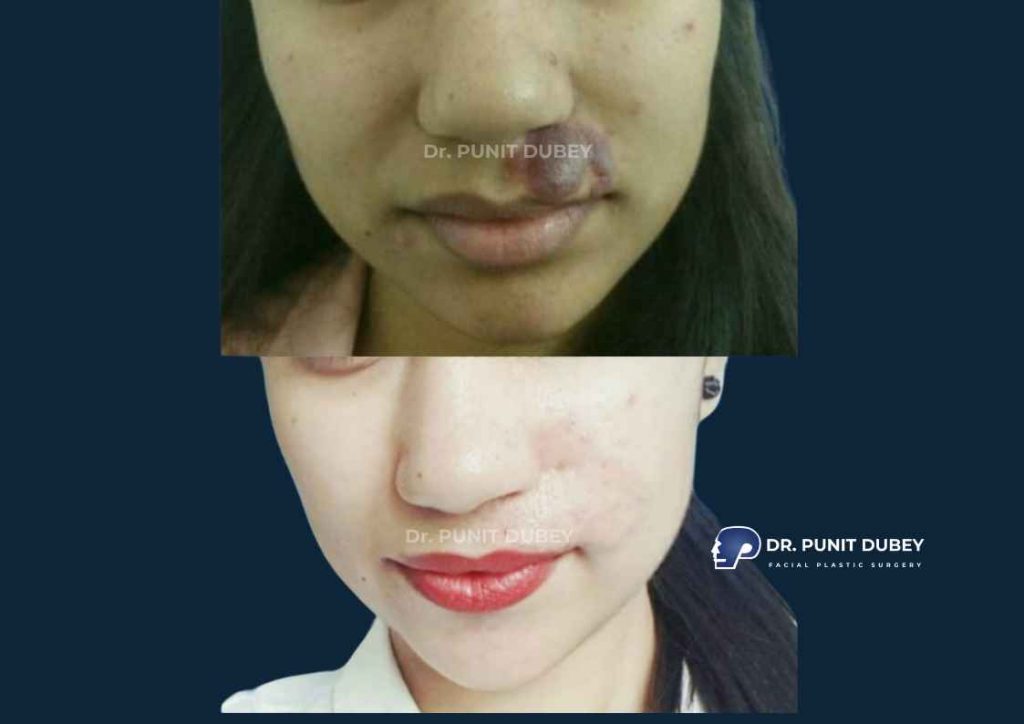
What Affects the Cost of Facial Birthmark Removal?
The cost depends on multiple variables, including:
- Type of birthmark: Vascular lesions like port wine stains or hemangiomas may require multiple laser sessions, while pigmented or epidermal nevi may need surgical excision.
- Size and depth: Larger and deeper pigmented patch are more complex to remove, often requiring advanced techniques or staged treatment.
- Technique used:
- Laser therapy (non-invasive, often multiple sessions)
- Surgical excision (involves operating room charges, anesthesia, sutures, and follow-up)
- For best results, vascular and pigmented birthmarks often require multiple treatment sessions, spaced out over time.
- Location on the face: Areas involving delicate structures (eyelids, nose, lips) may involve additional precision or specialist intervention.
- Surgeon’s expertise and clinic facilities: Experienced surgeons using advanced equipment in metropolitan centers like Delhi may charge more — but offer safer, longer-lasting results.
Estimated Cost Range in India
Here is a general overview:
Procedure Type | Approximate Cost (INR) |
Laser facial birthmark removal | ₹3,000 – ₹10,000 per session |
Surgical excision (minor lesion) | ₹25,000 – ₹50,000 |
Surgical excision (larger lesion) | ₹60,000 – ₹1,00,000+ |
Combined laser + surgical protocol | ₹50,000 – ₹1,50,000 |
Note: These are indicative prices. A detailed consultation is essential for an accurate quote based on your specific case.
Is Facial Birthmark Removal Covered by Insurance?
In most cases, birthmark removal is considered a cosmetic procedure, and therefore not covered by standard health insurance policies. However, if:
- Interferes with function (vision, breathing, speech)
- Has medical complications (bleeding, ulceration)
- Carries a risk of malignancy
Then your insurance provider may consider partial or full coverage under reconstructive or medically necessary treatment.
Always consult your insurer with supporting documents and a detailed report from your surgeon to confirm eligibility.
Discover compelling Facial Birthmark Removal Before and After case results
Seeing the before and after results of facial birthmark removal often provides the most reassurance for those considering treatment. These transformations not only reflect visible changes in skin appearance but also highlight powerful emotional and psychological improvements.
What to Expect from Facial Birthmark Removal Results
The results depend on several factors:
- Type and size of the skin discoloration
- Technique used — laser, surgery, or combined approach
- Skin type and healing response
- Age at the time of treatment — earlier treatment often yields better outcomes
Common Improvements Observed:
- Pigmented birthmarks can show considerable fading or even full clearance, depending on depth and skin response.
- Reduction in vascular discoloration and thickness in port wine stains or hemangiomas
- Elimination of hair-bearing or textured patches with surgical excision
- Achieves better facial balance and smoother, more uniform skin tone
- Reduction in social anxiety, especially for visible lesions on the cheeks, nose, or forehead
We often see the most dramatic changes in:
- Children with large hemangiomas that are treated early with laser or medication
- Adults with congenital moles or sebaceous lesions often benefit from complete surgical removal
- Patients with café au lait spots significantly faded after multiple laser sessions
Note: Every case is unique. While some birthmarks are completely removed, others may require staged treatments for optimal cosmetic blending.
Post-Treatment Follow-Up
- Ongoing scar care or laser resurfacing may be recommended
- Sun protection is critical to avoid pigmentation changes
- Regular reviews ensure no recurrence or complication
Dr. Punit Dubey ensures every patient receives personalized care, with pre- and post-treatment photos used to track progress and satisfaction.
FAQs on Facial Birthmark Removal in India
Does facial birthmark removal cream work?
Most over-the-counter creams marketed for congenital skin mark have limited or no proven effectiveness, especially for deeper or vascular pigments. While some may slightly lighten pigmented marks over time, they are not effective for port wine stains, hemangiomas, or raised lesions. Professional evaluation is the best first step toward real, lasting results.
Is birthmark removal painful?
Discomfort varies based on the technique:
- Laser treatments feel like tiny pinches or snaps and are often done without anesthesia or with numbing cream.
- Surgical removal is performed under local or general anesthesia, so the procedure itself is painless. Mild soreness or tightness may follow, but it’s typically manageable with prescribed medications.
Is birthmark removal safe?
Yes — when performed by a qualified surgeon using modern techniques, facial birthmark removal is considered very safe. Choosing the right specialist and following aftercare instructions significantly reduces the risk of complications such as scarring, infection, or pigment changes.
What is the cost of facial birthmark removal in Delhi?
Average facial birthmark removal cost in Delhi ranges depending on various factors like the birthmark’s size, its category, and the type of procedure chosen:
- Laser treatments typically range between ₹3,000 and ₹10,000 per sitting, with final pricing based on the number of sessions required.
- Surgical removal: ₹25,000 – ₹1,00,000+
- Combined treatments may go higher
A personal consultation is required for an accurate estimate.
Wondering how to remove a birthmark from the face permanently?
- Achieving permanent results relies on how deep the birthmark extends and its underlying cause.
- Laser therapy can permanently lighten or eliminate many vascular and pigmented lesions over multiple sessions
- Surgical excision is often recommended for birthmarks that are raised, coarse, or contain hair follicles
- Some lesions may fade partially but not disappear completely; ongoing care can still dramatically improve appearance
Can you remove birthmarks on the face?
Yes. Most facial birthmarks — including vascular, pigmented, and nonmelanocytic types — can be treated or removed safely with laser, surgery, or a combination of techniques. Consultation with a skilled facial surgeon ensures the best approach for your specific case.
Is birthmark removal permanent?
In most cases, yes. Surgical excision typically offers permanent removal, while laser treatments can permanently fade or eliminate superficial lesions. However, some deeper vascular birthmarks may need maintenance or staged sessions for optimal results.

